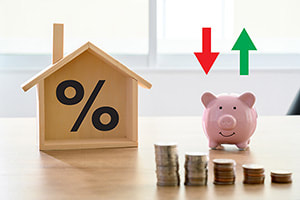 A dirty kitchen may be an eyesore, but it can also be a breeding ground for harmful bacteria. Here are three tips to maintain a clean kitchen: Make Your Own Sanitizing Cleaning Spray To kill bacteria like E. coli and salmonella, you need a cleaning agent that effectively disinfects surfaces. Bleach is an excellent choice for this task because it contains hypochlorite, which destroys bacteria. Many commercially produced household cleaners contain bleach, but you can save money by making your own. Combine 1 part bleach to 10 parts water in a large spray bottle—many spray bottles even come with marks on the side to indicate the ratio of the mix. Add a drop of dish soap and you have the perfect disinfectant spray. Sanitize or Replace Your Sponge Often A sponge is the perfect incubator for harmful bacteria because it stays damp, which allows bacteria to multiply. Kill bacteria by microwaving your completely wet sponge for one minute—make sure there aren't any metallic parts. Another way to sanitize your sponge is to place it in the dishwasher and set the machine to dry at the hottest setting and longest run cycle. It's a good idea to replace your kitchen sponges every month. Don't Forget to Hit Overlooked Spots Wiping down countertops with a disinfectant solution is important, but don't forget frequently neglected surfaces. For example, the refrigerator door handle is a prime spot for bacteria—after all, everyone in the house probably touches it once a day. Similarly, your faucet, cupboard handles, and knobs deserve a frequent once-over. If you have a garbage can in your kitchen, don't forget to clean the lid; you can also take the empty can outside, fill it with water and a few squirts of dish soap, rinse, and let it sit in the sun to dry. Get into the habit of giving your kitchen a quick sanitizing wipe down before preparing food and a deeper clean once a week. It could be vital to your health, and it will also keep your kitchen—the heart of your home—sparkling clean and fresh.
0 Comments
 Mortgage rates are hitting historic lows. According to the Freddie Mac Primary Mortgage Market Survey, the 30-year fixed-rate mortgage for the week ending July 2 averaged 3.07%; this is the lowest rate ever recorded in the survey's 49-year history. At the same time last year, the 30-year fixed-rate mortgage averaged 3.75%. According to Sam Khater, chief economist for Freddie Mac, "On the economic front, incoming data suggest the rebound in economic activity has paused in the last couple of weeks with modest declines in consumer spending and a pullback in purchase activity." All of this suggests that the 30-year fixed-rate mortgage could drop below 3% by the end of 2020. Home Sales Are Down The coronavirus outbreak led to a decline in existing-home sales over the past three consecutive months. According to the National Association of Realtors (NAR), every sales region in the country experienced drops in both month-over-month and year-over-year sales. "Sales completed in May reflect contract signings in March and April—during the strictest times of the pandemic lockdown and hence the cyclical low point," says Lawrence Yun, chief economist for NAR. As the economy starts up again, Yun expects home sales to increase in the second half of the year. Housing Inventory Falls Below Last Year's Levels By the end of May, there were 1.55 million units available for sale, up 6.2% from a month earlier but down 18.8% from May 2019. At the current sales pace, the housing stock would supply the market for 4.8 months; in comparison, there was a 4-month supply in April and a 4.3-month supply a year ago. Of all the homes sold in May, 58% remained on the market for less than a month. On average, properties remained available for sale for 26 days, unchanged from May 2019. Home Prices Are Up Home sales might have declined, but home prices are still increasing. The median existing-home price increased in every area except the West. This was the 99th consecutive month of year-over-year price increases. Yun believes that a boost to new home construction is needed to meet an increase in housing demand; "otherwise, home prices will rise too fast and hinder first-time buyers, even at a time of record-low mortgage rates." Regional Sales Breakdown Northeast: Existing-home sales annual rate of 470,000; a decrease of 13% from April 2020 and 29.9% from May 2019. The median sales price increased 7.8% from May 2019. Midwest: Existing-home sales annual rate of 990,000; a decrease of 10% from April 2020 and 20.2% from May 2019. The median sales price increased 3% from May 2019. South: Existing-home sales annual rate of 1.73 million; a decrease of 8% from April 2020 and 25.1% from May 2019. The median sales price increased 2.1% from May 2019. West: Existing-home sales annual rate of 720,000; a decrease of 11.1% from April 2020 and 35.1% from May 2019. The median sales price decreased 0.2% from May 2019. here to edit.  Are you thinking about remodeling your home or starting a backyard patio project? If you're not a detailed or ambitious person, you may need to hire a contractor to perform some or all the work. Do your homework and be crystal clear with your remodeling or landscaping contractor to reduce miscommunication and expensive errors. Here are some time-tested tips from FindLaw.com, the world's leading online legal resource: 1. Does it make sense? Before moving too quickly, ask yourself if it makes sense to remodel. Are other neighbors enhancing the exteriors of their homes and improving their yards? Are you preparing to sell your house or planning to stay a while? While an important move, remodeling and landscaping can be expensive, and you may not fully recoup your investment. 2. Do your homework. Before calling a contractor, figure out what you want. Visit showrooms, talk to friends and neighbors who have recently remodeled, or read home and landscaping magazines. Start a notebook to collect your ideas, product information, and samples. 3. Build a budget. Keep in mind, especially when remodeling an older home, there may be unexpected surprises (such as plumbing or electrical) that could drive up costs. To be on the safe side, add 20% to the generally recommended costs of a remodeling project. 4. Get a recommendation. When searching for a contractor, word-of-mouth is a reliable method. Ask your friends and family if they have worked with a contractor or landscaper recently, or reach out to your real estate agent for a professional they recommend. Make sure the contractor is licensed, bonded, and insured. Always get at least three proposals from different contractors and compare the details. 5. Check your permits. Be wary of the contractor who says you don't need to pull a permit from city hall for your project. A permit represents the minimum construction standard set by a local community and protects the homeowner from shoddy construction or landscaping practices. If you live in a historic neighborhood, there may be more restrictive guidelines to follow. 6. Get it in writing. Never agree to hire a contractor, even if it's your brother-in-law, on a verbal agreement. Always insist on a contract. Be precise about what services will be performed and due dates. Specify what products and materials will be used. Spell out when payments will be made to the contractor, and clarify your rights if the work is not completed to your satisfaction. If need be, contact an attorney to review the document before signing. 7. Be completely satisfied. Never pay for the entire project upfront before construction begins. In most cases, you'll put down 25% of the total project before it starts, then make payment portions at milestones up until its completion. Withhold your final payment until the project is completed to your satisfaction.  In many real estate markets across the United States, home affordability is a major obstacle to homeownership. There's a short supply of entry-level starter homes, and oftentimes, homebuyers are in a crunch looking for a "deal"—a home priced below market value or one that doesn't involve a bidding war to buy. However, not every home that appears to be a deal is one. Here's how to know when a deal isn't a deal. It Needs a Lot of Work A home that needs a lot of work can be a deal, but only if its expenses are already built into the sales price. For example, a home priced $50,000 below market value because it needs $50,000 of work is fair. But a home priced $20,000 below market value needing $50,000 of work is a bad deal. The seller is asking the buyer to pay over market value, with the costs of repairs considered. Think carefully about buying a house that needs major renovations—the costs often outweigh the savings. Everywhere Becomes a Drive Some homebuyers are willing to sacrifice location for a home they can afford. Living near or far away from a city can sometimes be the difference between being a homeowner and not. But if you've added an hour each way to your work commute, those extra two hours a day spent in your car or on public transportation could get old in a hurry. You might wind up regretting buying a home so far away from your job, your family and friends, your favorite restaurant, or your family doctor. You'll have to decide between dollar savings and the inconvenience of traveling long-distance everywhere. Too Many Compromises Every homebuyer begins a search with a list of expectations and must-haves. Depending on the price, you might be willing to compromise some of the things on your wish list. But compromising on things that are most important to you—the number of bedrooms, a good school district, a crime-free area—could end up being a daily drain on you. Giving up too many of your priorities might not be worth the savings. Affordability is an issue in real estate markets, so finding deals on homes sounds great. But a low price doesn't necessarily equal a deal, and it's helpful to recognize those situations. As a skilled real estate professional, I can help you find the home that best fits your lifestyle. Mortgage rates are at historic lows. Now is a good time to buy or list your home. Contact me today!  The CALIFORNIA ASSOCIATION OF REALTORS® released its June housing market report last week and it showed an unprecedented rebound in closed sales and the state also set a new all-time high price of more than $623,000. Additionally, the economy has enjoyed a variety of positive reports in the past week on interest rates and the labor market. And yet, even as we continue to make solid progress, some of our pre-crisis structural issues have reasserted themselves and the near-term economic uncertainty has increased significantly as well. Things continue to slowly improve, but it is clear that a full recovery is still a long way off. California’s housing market recovers significant lost ground in June: After a record 41.4% decline in closed transactions in May 2020 due to coronavirus-related shelter in place orders, California saw the number of home sales rebound sharply in June. Home sales increased by more than 40% on a month to month basis. And although California is still below 2019 levels by 12.8%, it is a marked improvement from the sub-300,000 levels of April and May. California’s unemployment falls amidst record job growth in June: California’s unemployment rate edged down from 16.4% in May to 14.9% in June as nonfarm payrolls swelled by more than 500,000. This marks the second consecutive monthly gain and means that California has already recovered nearly 700,000 of the roughly 2.6 million jobs lost in March and April. More REALTORS® closed a transaction last week: The percentage of California REALTORS® that had a transaction close escrow last week increased slightly from 24% two weeks ago to 26% last week. Low rates have been translating into increased demand for home showings and a trend of rising mortgage applications since mid-April and although supply remains tight, California has seen many of those pending sales from April and May eventually close. Pending sales increased for first time in 4 weeks: C.A.R.’s latest weekly analysis of MLS data across California reveals that pending sales increased for the first time in 4 weeks to an average of nearly 1,100 homes entering escrow per day last week. Prior to last week, home sales had been declining since late June. However, pending sales in California have now been above their pre-coronavirus levels for 11 weeks in a row. Closed sales decline for first time in 10 weeks: Despite the solid June report on California’s housing market, the weekly MLS data shows that closed transactions declined for the first time since the week of May 9th. Previously, we have reported on flat or declining pending sales and this result is largely consistent with the slowdown in homes entering the escrow process we have observed over the past month. Pending sales suggest a slow August: Although pending sales increased last week for the first time in nearly a month, the level of pending sales has been essentially flat for much of the past month. This suggests that although July may see closed sales shoot back into positive territory, more robust growth in August and September remains very much in question as the pace of new escrows subsides. Inventory remains a significant challenge for California’s housing recovery: One key reason the recent rebound is losing momentum in recent weeks is that there is not enough inventory on the market for buyers to purchase. A myriad of indicators from jobs to spending to requests for home showings or new mortgage applications show that consumers continue to want to purchase a home, but the 43% decline in active listings across the state in June compared with last year have prevented many of these buyers from being able to do so. More transactions are falling out of escrow, fewer members getting into escrow last week: The economy has made significant progress since mid-April, but a recent survey of California REALTORS® suggests that the recent increase in uncertainty has had a modest impact on their business. In the survey conducted over the weekend, the percentage of REALTORS® that had a transaction fall out of escrow during the week remained at 6%--slightly elevated from 5% three weeks ago. In addition, the percentage of respondents that entered escrow on a new transaction fell to 26% last week from 30% the previous week. This was the second consecutive decline. Consumer sentiment declines in July as some businesses reclose: After recovering slightly in May and June, the University of Michigan’s preliminary estimate of consumer sentiment reversed course last week amidst re-shelter-in-place orders and general economic uncertainty. This is significant because consumer spending is still responsible for roughly 70% of the U.S. economy, which means a v-shaped recovery and much harder to achieve when consumers aren’t increasing their spending. Last week was another week of contrasts: record job growth, record increases in home sales, new all-time high levels of home prices, and all-time low levels of interest rates contrasted against new closures in the state, rising initial claims for unemployment insurance, declining consumer confidence, and increasing difficulties in addressing the pandemic. It is hard to look at the data and not be optimistic about the progress we’ve made in the past three months, but it is equally hard to look ahead and not see increased economic uncertainty as well. |
AuthorA variety of pertinent real estate topics and tips from various authors and contributors. Archives
December 2024
Categorieshow much home can i afford?*
|



